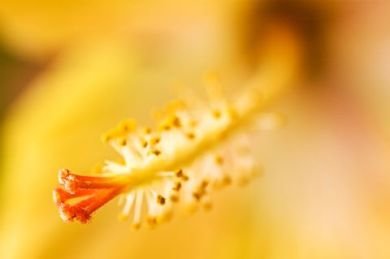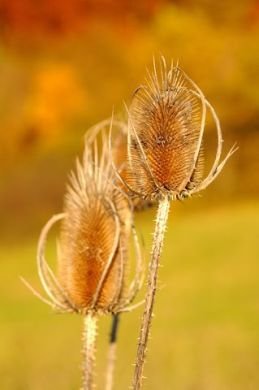How Do Plants Grow?
How do plants grow is a good question that the beginner gardener needs to know. Plants will not only create a beautiful butterfly garden, but also can become undesirable garden weeds.
Regardless of beautiful flowers or garden weeds, this page covers both the question of how plants grow and how to eradicate them.
"One year's seeds make seven years' weeds."
How true! Some annual weeds can easily produce 60,000 seeds
per square yard, lambs quarter can produce 70,000 seeds on a single plant! This equals several generations of weed seeds.
How do plants grow when they are annuals?

| Photo: Antonius Lecuona |
An annual is any plant that lives for one year. Annuals reproduce by seed, but some can start to grow new plants from their roots in the ground, although this doesn't happen as often.
Seeds spread by insect pollination, wind, water, animal transference, etc. The gardener can also grow plants from seed.
During it's twelve month life cycle the annual:
- sprouts from a seed
- grows
- flowers to set new seeds
- dies
1) There are two categories of annual weeds: Winter and Summer
- Summer Annuals grow primarily spring through fall and die after the first frost.
- Winter annuals sprout in the fall, will grow a few inches and then go dormant in winter. In early spring, winter annuals resume growing, set seed in summer and die when the summer heat hits.
how do plants grow
2) Controlling annual weeds:
-
Manually removing weeds:
The goal would be to never let weeds seed. This can be done by using a hoe to take off blooms before seeds are produced falling to the ground.
1) Pull weeds when they are just a sprout, root and all. Do this in the spring and fall. Once annual weeds have their flowers, if pulled, seeds will fall to the ground, starting the process over again.
2) Using different mulch types prevents sunlight from germinating seeds by photosynthesis. Seeds that are present in the soil can sit for years without germinating if the sun can't get to them. Outside of organic mulch, inorganic mulch types are a very good option to.
-
Using herbicides:
Different herbicides are used for different purposes. A pre-emergent herbicide is what is used for killing any germinating seed, which most seeds are found in the top 2" of soil. Pre-emergent's are ineffective if there is a sprouting weed. This is when a post emergent weed control is what is needed.
1) Timing is key with a pre-emergent. Factors such as soil type, weather and depending on herbicide, influence effectiveness. Chemicals can remain in soil from a few weeks to 3 or 4 months. The best bet is to get into a routine of understanding germination of summer and winter annuals and apply pre-emergent herbicide around this.
2) Depending on the task at hand try any homemade weed killer. Many are a preemergent and post-emergent herbicide. Use caution, especially if kids or pets are around.
how do plants gr
- Mowing is valuable for weed control in the lawn:
Studies have shown mowing grass high and regularly reduces weed seeds from germinating, ultimately lowering annual weed populations over time. This is key when understanding how do plants grow when they are unwanted in the lawn.
If annuals do sprout, lawn mower can control their spread making sure the flower doesn't grow and if it should, seeds are blown around where they are unable to get established. Sharp blades also help prevent seeds from sticking on them, helping them to blow around.
If mower blades are set to mow lawn 2" or less, weeds will grow more over the years with soil exposure to the sun and is found to also weaken grass roots. It was especially shown that 1 1/4" was the point where most germination occurred.
Mowing grass higher at 2 1/4 - 3" reduced weeds drastically over years. By doing so shades the soil and cools it better from sun drastically reducing seed germination.
Keep in mind that mowing height for grass is considered the distance between mower blade and soil. Attaching a clipper bag also helps to get rid of seed and can be used for compost.
3) Examples of Annual Weeds are:
|
|
How do plants grow when they are biennials?
|
This stored energy is used to survive the winter and in spring grows to create the second years flowering stems. Some stems of the biennial have leaves, some don't. Once the flower produces and sets seeds the plant dies. |

|
During the two year cycle a biennial:
- Sprouts from a seed
- Grows and sets leaf rosette to store up energy
- Dormant in winter
- Flowers to set new seeds
- Dies
how do plants grow
1) Controlling biennial weeds:
- Manually Removing Weeds: The best method of weed eradication is to dig out the entire leaf rosette, roots and all. This is best done in the first year, but if cluster can be cut out in spring before stems form, this will work too.
In it's second year biennial's reproduce by seed but as with annuals - some can still grow by roots.
2) Follow the above guidelines for weed control of annuals.
3) Examples of biennials are:
- Biennial Thistle's - Bull, Musk, Spear, Tall, etc..
- Burdock
- Caper spurge
- Garlic Mustard
- Goat's beard
- Hogweed
- Queen Anne's Lace
- Common Mallow
How do plants grow when they are Perennials?
|
|

|
1) How do plants grow? Food energy stored by:
- Taproot:
Taproots are underground stems that spread. If cut and not completely removed, it's highly likely that taproot will sprout more growth producing more plants. So where there was only one before will turn into more.
- Stolons
These are stems that run above the ground and take root when they touch the ground. Stolons, often termed runners, are a slender stem-branch that grows away from main plant running above soil line and also below. Sometimes stems bend over and also produce roots. When above the soil line, buds are produced at the tips and root. These can also be called creeping perennials, which mat and can crowd out grasses.
- Tubers
This is a thick, fleshy solid mass looks like a potato, but can have different shapes. The tuber sits horizontally underground and buds form roots and shoots that will grow the plant. Tubers store the energy overwinter to produce new growth in spring. Not all tubers grow as the plant grows. Some will actually diminish in size with plant growth.
- Rhizomes
Rhizomes are horizontal creeping roots that separate into pieces where it can be easily reproduced for propagation, even if finely chopped. This is also known as vegetative reproduction What is a rhizome? They are also roots, rootstalk and rootstock.
- True Bulb and/or Bulbil
A bulb is like a storage container that houses the flower that is already forming inside. It has fleshy leaves and a stem on the bottom that looks like a flat disc. In the center are the flower and stem. Bulbs look like an onion, many have an outside paper thin protection called a tunic. Bulbs are considered weeds when they tend to grow and spread rapidly. Field horsetail, quackgrass, and Canada thistle are weeds. Bulbs can reproduce by seed and bulbets from the parent bulb.
- Corms
A corm is a short, upright swollen stem base that is mass of tissue designed to store energy. They are usually round and flat without a point at the top like a true bulb. As a plant grows the corm shrivels. New corms, called cormels grow around but they don't usually begin to grow for a few years.
2) Controlling Perennial Weeds:
- Manually removing weeds:
|
What is above ground can be easily removed but it is the stored up energy sources beneath the ground that continue to reproduce. Options are: |

|
3) Starve the root system. By cutting off everything above the surface, roots use stored energy to create more stems and leaves. What is meant by starving the root system is to keep cutting down the growth until there is no more energy stored to create, or rebuild new plants.
It's important to keep cutting these types of weeds every 1-2 weeks because energy gets stored up again with photosynthesis of the sun. Do this especially in the fall because roots can be weakened to the point of not surviving the winter.
-
Using Herbicides:
Different types of herbicides kill different types of weeds. Understanding them can be confusing. Click for an outline which explains more of how herbicides work.
1) Apply pre-emergent weed killers to perennials to kill germinating seeds. Pre-emergent herbicides have been known to cause some damage to bulbs that can prevent them from growing.
2) This page doesn't discuss grass and broadleaf weeds (annual and perennial). But they are weeds and can be controlled with selective broadleaf herbicides.
3) Perennial grassy weeds are most difficult to control and kill once established. Non-selective herbicides are designed to kill grass weeds but can also kill good grass.
4) Glyphosate herbicedes are the most widely used to control grasses although they can be used on broadleaf weeds.
how do plants grow
3) Examples of perennial weeds on how do plants grow:
- Canadian Thistle
- Kudzu Vine
- Bindweed
- Dandelion
- Broad Leaved Dock
- Common Plantain
- Couch Grass
- Japanese Knot Weed
- Creeping Buttercup
- Stinging Nettle
Back from How Do Plants Grow to home page Easy Butterfly Garden
 Copyright © 2010-2022 Easy-Butterfly-Garden.com
Copyright © 2010-2022 Easy-Butterfly-Garden.com
Privacy Policy Disclaimer

Join Easy Butterfly Garden on Facebook
Recent Articles
-
Annual Bluegrass
Jan 14, 17 08:14 PM
Annual bluegrass (Poa annua) is considered a weed in the Poa family, which has a few popular turf grasses. If this gets into your butterfly garden listed are a few ways to eradicate it.
-
Candytuft Flowers
Sep 25, 16 10:54 PM
There are the annual, or Iberis, candytuft flowers and also perennials which are called Iberis sempervirens.
-
Keeping Deer Out
Sep 19, 16 01:10 PM
Reviewing the types of products available for keeping deer out of our gardens along with building fences. Many of these products help with other garden pests.
-
Butterfly Meadows
Sep 19, 16 12:52 PM
Compared to other wildlife gardening, butterfly meadows take time and are not for the faint of heart.
-
Natural Gardening
Sep 19, 16 12:32 PM
Natural gardening includes different types of gardens. These garden types create a casual, natural envirionment and help sustain native wildlife which includes butterflies.






New! Comments
Have your say about what you just read! Leave me a comment in the box below.